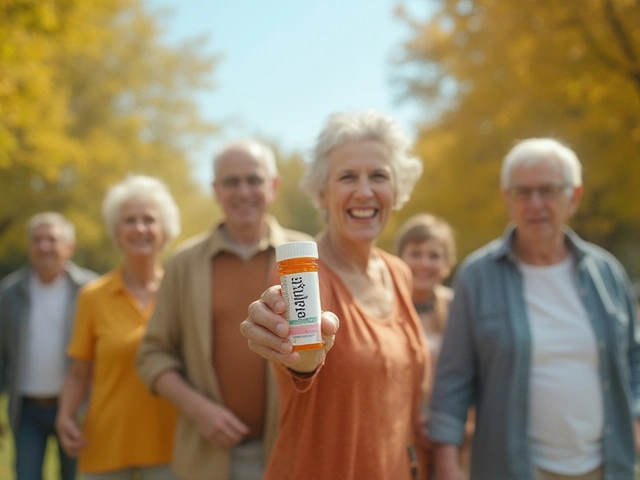COPD Risk Assessment Tool
Assess Your COPD Risk
Answer the questions below to calculate your personalized COPD risk score and receive tailored prevention recommendations.
Your COPD Risk Assessment
Personalized Prevention Recommendations
Did you know that obstructive pulmonary disease (COPD) is the third leading cause of death worldwide? While genetics play a role, most cases stem from everyday choices. Below you’ll find the exact steps you can take today to lower your risk and keep your lungs in shape.
Quick Takeaways
- Quit smoking and avoid second‑hand smoke - the single biggest protective move.
- Boost daily activity with aerobic exercise and specific breathing drills.
- Eat a diet rich in antioxidants, fiber, and lean protein.
- Stay up to date with flu and pneumonia vaccines.
- Limit exposure to indoor pollutants and outdoor smog.
What is Obstructive Pulmonary Disease?
Obstructive Pulmonary Disease is a group of progressive lung conditions that make it hard to exhale fully, trapping air in the lungs. The two classic forms are Chronic bronchitis and Emphysema. Together they impair gas exchange, leading to shortness of breath, chronic cough, and eventually respiratory failure.
The disease often goes unnoticed until symptoms become severe, which is why prevention matters more than treatment.
Why Lifestyle Changes Matter More Than Medication
Medications such as bronchodilators and inhaled steroids help manage symptoms, but they don’t reverse damage. Lifestyle choices, on the other hand, tackle the root causes-airway inflammation, oxidative stress, and mucus overproduction. Think of it as fixing the leak before the roof collapses.
1. Quit Smoking and Dodge Second‑Hand Smoke
Smoking is responsible for about 85% of COPD cases. The chemicals in tobacco smoke irritate airway lining, trigger chronic inflammation, and accelerate the breakdown of alveolar walls.
- How to quit: Use a combination of nicotine replacement (patches, gum), prescription aids (varenicline, bupropion), and behavioral counseling. The UK’s NHS Stop Smoking Service reports a 50% success rate when all three are combined.
- Avoid environments where others smoke. A 2023 study showed that even brief exposure to second‑hand smoke raises COPD risk by 20%.
2. Keep Air Quality Clean Indoors and Out
Both indoor pollutants (cooking fumes, wood burners, cleaning chemicals) and outdoor air pollution contribute to airway irritation.
- Install HEPA filters in bedroom and living‑room air‑handlers; replace them every 6‑12 months.
- Ventilate kitchens with exhaust fans while cooking, especially when using oil or frying.
- Check local air‑quality index (AQI) on apps like AirNow. On days when AQI exceeds 100, limit outdoor exercise or wear a N95 mask.

3. Move Your Body: Aerobic Exercise and Pulmonary Rehab
Regular physical activity improves lung capacity, strengthens respiratory muscles, and reduces systemic inflammation.
- Aim for at least 150 minutes of moderate‑intensity cardio (brisk walking, cycling, swimming) each week.
- Include strength training twice weekly to support posture and diaphragm function.
- Consider a structured pulmonary rehabilitation program if you already have mild symptoms-studies show a 30% reduction in hospital admissions.
4. Practice Targeted Breathing Exercises
Breathing drills help empty trapped air and improve oxygen exchange.
- Pursed‑lip breathing: Inhale through the nose for 2 seconds, exhale slowly through pursed lips for 4 seconds. Repeat 5‑10 times, especially during exertion.
- Diaphragmatic breathing: Lie on your back, one hand on chest, one on abdomen. Focus on belly rise, keeping the chest relatively still. Perform 5 minutes daily.
- Apps like “Breathwrk” provide guided sessions for beginners.
5. Eat for Lung Health
Nutrition influences inflammation and immune defense. A diet rich in antioxidants, omega‑3 fatty acids, and fiber can lower COPD progression.
| Nutrient | Typical Source | Effect on Lungs |
|---|---|---|
| Vitamin C | Citrus, berries | Reduces oxidative stress |
| Vitamin D | Fat‑fish, fortified milk | Improves immune response |
| Omega‑3 | Salmon, flaxseed | Lowers inflammation |
| Fiber | Whole grains, legumes | Supports gut‑lung axis |
Swap processed foods for whole‑food alternatives. A 2022 cohort of 10,000 UK adults found that those in the highest quartile of fruit/veggie intake had a 25% lower incidence of COPD.
6. Stay Up to Date with Vaccinations
Respiratory infections can accelerate COPD exacerbations. The NHS recommends annual flu shots and a one‑time pneumonia vaccine (PCV13 or PPSV23) for at‑risk adults.
- Even if you’re otherwise healthy, getting vaccinated cuts the chance of a severe lung infection by roughly 40%.
- Discuss with your GP whether you qualify for the newer 20‑valent pneumococcal vaccine (approved 2024).
7. Manage Weight and Stress
Both obesity and chronic stress increase the work of breathing and raise inflammatory markers.
- Maintain a BMI between 18.5 and 24.9. Even modest weight loss (5-10% of body weight) can improve dyspnea scores.
- Practice stress‑relief techniques: mindfulness, yoga, or short walks in nature. A 2021 trial linked mindfulness‑based stress reduction to a 15% drop in COPD‑related hospital visits.
Putting It All Together: A Daily Checklist
- ☑️ No tobacco, no exposure to second‑hand smoke.
- ☑️ Open windows for fresh air; run HEPA filter.
- ☑️ 30‑minute brisk walk + 5‑minute breathing drills.
- ☑️ Breakfast: oatmeal with berries + flaxseed.
- ☑️ Lunch: grilled salmon, mixed greens, quinoa.
- ☑️ Evening: pursed‑lip breathing before bed.
- ☑️ Check flu‑vax status; schedule pneumonia shot if due.
Following this routine consistently can shave years off a potential COPD diagnosis.
Common Pitfalls and How to Avoid Them
- Thinking “I’m too young”: COPD can develop in people in their 30s, especially if they vape or work in dusty jobs.
- Skipping the warm‑up: Jumping straight into high‑intensity cardio can provoke airway irritation. Start with 5 minutes of gentle marching.
- Relying on gadgets alone: Apps are helpful, but real‑world monitoring (peak flow meter, symptom diary) provides actionable data.
When to Seek Professional Help
If you notice any of the following, book a GP appointment:
- Persistent cough lasting more than 3 weeks.
- Shortness of breath during everyday tasks.
- Frequent chest infections.
- Wheezing or chest tightness.
Frequently Asked Questions
Can I reverse COPD with lifestyle changes?
Complete reversal is rare, but slowing progression and improving quality of life are realistic goals. Quitting smoking, exercising, and proper nutrition can reduce symptom severity by up to 40%.
How much exercise is enough to protect my lungs?
The NHS recommends at least 150 minutes of moderate‑intensity aerobic activity per week, plus two strength sessions. Split it into 30‑minute walks five days a week for consistency.
Are e‑cigarettes safer than regular cigarettes?
E‑cigarettes still deliver nicotine and aerosolized chemicals that irritate the airways. Current evidence shows a 30% increased risk of COPD compared with never‑smokers, so quitting all forms of smoking is best.
What role do vaccines play in COPD prevention?
Flu and pneumococcal vaccines reduce the chance of severe respiratory infections that can trigger COPD flare‑ups. Annual flu shots and a one‑time pneumonia vaccine are strongly advised for adults over 40.
Is there a specific diet that protects the lungs?
A Mediterranean‑style diet-high in fruits, vegetables, whole grains, fish, and olive oil-provides antioxidants and omega‑3s that combat lung inflammation. Limit processed meats and sugary drinks, which are linked to higher COPD risk.





One comment
I keep thinking about the families who lose a parent to COPD and how that empties a house of laughter. The statistics are more than numbers; they are stories of breath that was stolen too soon. It feels overwhelming to read about prevention steps when the damage feels already done.
Indeed, the preventive measures outlined are both evidence‑based and pragmatically attainable. Implementing them constitutes a disciplined, health‑centric lifestyle.
Oh, brilliant, because we all have endless free time to schedule aerobic sessions between meetings and existential dread. Truly, the solution to COPD is a daily jog and a kale smoothie, as if life were that simple.
While the article admirably covers the major risk factors, it glosses over occupational exposures that are pivotal in many developing economies. For instance, workers in construction or mining often inhale silica dust, a known accelerator of airway obstruction. Moreover, the recommendation to “install HEPA filters” neglects the socioeconomic barrier for low‑income households. The suggestion to “check AQI on apps” assumes universal smartphone access, which is far from reality. A more nuanced approach would segment recommendations by socioeconomic strata, ensuring practicality across diverse populations.
Great points overall but maybe add a note about staying hydrated during exercise
I totally get the struggle of balancing cardio with a busy schedule; the key is integrating low‑impact interval training into daily routines. Think of it as micro‑bursts of metabolic conditioning that still boost ventilatory efficiency without overtaxing the respiratory muscles.
In many cultures breath is seen as the spirit’s whisper, so protecting lungs is almost a spiritual duty. Yet modern industrial haze threatens that ancient bond, making us question how we can reconcile progress with the sanctity of our own respiration.
Let’s crank up that enthusiasm! A 30‑minute brisk walk can feel like a victory lap against the invisible enemy of smog, and every step you take pumps fresh oxygen straight to your cells.
Wake up, people! The smog you blame on traffic is actually a covert operation to thin the population, making us all cough and wheeze while they watch from the shadows. Don’t be fooled by the glossy‑look health ads – they’re just a smoke screen.
Remember, consistency is the cornerstone of pulmonary resilience; integrating diaphragmatic breathing drills into your pre‑workout warm‑up can amplify tidal volume and reduce airway resistance over time.
Keep at it you’re doing great and every habit adds up for stronger lungs
When considering COPD prevention, the sheer breadth of lifestyle modifications can feel daunting, yet each component is a vital cog in the protective machinery of our respiratory system. Firstly, quitting smoking is non‑negotiable; nicotine addiction not only fuels inflammation but also erodes the delicate alveolar structures that facilitate gas exchange. Secondly, routine aerobic activity, whether it’s brisk walking, cycling, or swimming, elevates cardiovascular output, thereby enhancing oxygen delivery to peripheral tissues and preventing deconditioning. Thirdly, targeted breathing exercises such as pursed‑lip and diaphragmatic techniques serve to unload trapped air, improve ventilation efficiency, and reduce dyspnea during exertion. Fourth, nutritional choices rich in antioxidants-think citrus fruits, berries, leafy greens-and omega‑3 fatty acids found in fish, directly combat oxidative stress that otherwise accelerates lung tissue damage. Fifth, maintaining optimal indoor air quality by employing HEPA filters and reducing exposure to volatile organic compounds mitigates chronic irritant exposure. Sixth, staying current with vaccinations, particularly influenza and pneumococcal shots, shields the lungs from infectious insults that can precipitate acute exacerbations. Seventh, body weight management alleviates the mechanical load on the chest wall, making breathing less laborious. Eighth, stress reduction through mindfulness or yoga lowers systemic cortisol levels, which have been linked to heightened inflammatory markers in pulmonary tissues. Ninth, regular health check‑ups, including spirometry for at‑risk individuals, enable early detection and timely intervention before irreversible damage sets in. Tenth, limiting exposure to outdoor pollutants by monitoring the AQI and adjusting outdoor activities accordingly prevents additional airway irritation. Eleventh, fostering a supportive social network encourages adherence to these habits, as accountability often drives sustained change. Twelfth, avoiding second‑hand smoke in public and private settings eliminates a hidden source of toxic inhalants that can undermine personal efforts. Thirteenth, educating oneself about occupational hazards-such as dust, fumes, and chemicals-ensures proper protective measures are taken at work. Finally, embracing a mindset of proactive health stewardship transforms these recommendations from a burdensome checklist into an empowering daily ritual that preserves lung function and enhances overall quality of life.
The breath we claim as ours is merely borrowed time.
They’re definitely hiding the real data about air quality in plain sight, and we’re all gonna suffer while they profit from the smog.
Studies also show that regular yoga practice can improve lung elasticity, offering another low‑cost tool for COPD prevention.